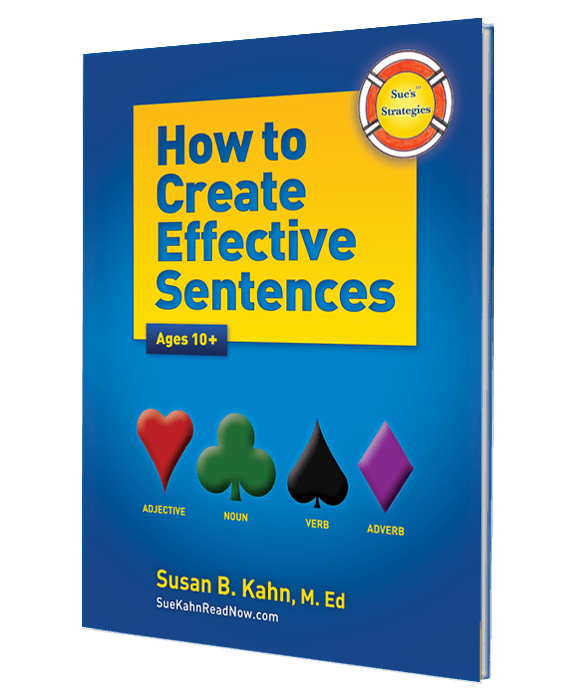Sue's Strategies
How To Create Effective Sentences, Ages 10+
This text improves reading, writing, and fluency.
It feels like a game, engages attention like a puzzle, and makes learning fun. Although designed for youngsters in Grade 5 and up, high-school and even college students could benefit from these lessons and exercises.
How To Create Effective Sentences Ages 10+
Sue’s Strategies How to Create Effective Sentences offers a powerful set of grammatical tools to improve reading comprehension, reading fluency, and writing skills. Susan Kahn takes apart the various components of sentences and repackages them into lessons on how to create, to inspire, and to convey one’s thoughts.
Her examples, illustrations, and card symbols enable students to learn quickly and remember well the essentials of grammar. Since dyslexic people, English Language Learners, and others may unknowingly misunderstand what they hear and read, learning syntax usually enables them to overcome such difficulties. In addition, students learn several grammatical options for expressing their thoughts. To develop mastery of syntax, students complete interesting, self-correcting practice exercises filled with facts about American history.
Sue’s text explicitly and systematically teaches the following content:
- The basic parts of speech are explained and paired with card symbols as a memory tactic: red hearts for adjectives, green clubs for nouns, black spades for verbs, and purple diamonds for adverbs;
- Phrases: infinitive, prepositional, participial, gerundive;
- Clauses: adjective, adverb, noun;
- Pronouns: personal, possessive, demonstrative;
- Verbs: helping verbs, linking verbs, main action verbs.
More advanced lessons reveal the flexibility of the English language. For example, a word ending in ING may be used as a verb but recycled to become an adjective or a noun. People who understand the functions of ING ending words should not be confused when reading or writing ING words. Identification of usage for a word or group of words is a critical element for comprehension. To develop mastery, Sue’s text provides self-correcting practice exercises through color such as: red for adjective constructions, green for noun constructions, black for verbs, and purple for adverb constructions. The lessons progress in a logical, cumulative sequence to improve reading and writing skills through grammar. As a result, students of Sue’s Strategies feel empowered and self-confident in their reading comprehension and sentence writing.

